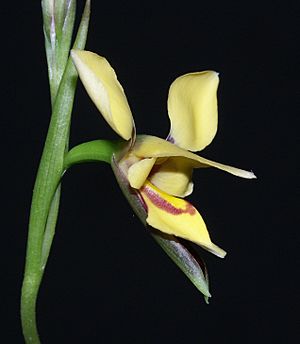Tall donkey orchid facts for kids
Quick facts for kids Tall donkey orchid |
|
|---|---|
 |
|
| Conservation status | |
| Scientific classification | |
| Genus: |
Diuris
|
| Species: |
drummondii
|
The Diuris drummondii, also known as the tall donkey orchid, is a special type of orchid. It grows only in the south-west part of Western Australia. This means it is "endemic" to that area. It is the tallest of all the Diuris orchids. Its flowers are pale yellow with brown marks. You can tell it apart from a similar orchid, Diuris emarginata, because its flowers are bigger and spaced further apart.
Contents
About the Tall Donkey Orchid
The tall donkey orchid is a plant that grows from a tuber, which is like a small underground storage part. It is a "perennial herb," meaning it lives for more than two years and does not have a woody stem. This plant can grow quite tall, from about 50 millimeters (2 inches) up to 1.5 meters (5 feet) high.
It usually has three to six leaves. Each leaf can be between 150 to 250 millimeters (6 to 10 inches) long. They are also about 5 to 8 millimeters (0.2 to 0.3 inches) wide.
What the Flowers Look Like
Each tall donkey orchid plant has about three to seven flowers. These flowers are pale yellow with brown patterns. They are quite wide, measuring about 30 to 35 millimeters (1.2 to 1.4 inches) across.
The top part of the flower, called the "dorsal sepal," stands upright. It is about 18 to 22 millimeters (0.7 to 0.9 inches) long. The side sepals point downwards. They are about 18 to 24 millimeters (0.7 to 0.9 inches) long.
The petals look like ears and sit above the rest of the flower. The main part of the petal is about 17 to 20 millimeters (0.7 to 0.8 inches) long. It sits on a dark stalk that is about 6 to 8 millimeters (0.2 to 0.3 inches) long.
The "labellum" is a special lip-like part of the orchid flower. It is about 17 to 22 millimeters (0.7 to 0.9 inches) long and has three sections. The middle section is shaped like an egg. It is about 15 to 18 millimeters (0.6 to 0.7 inches) long. The side sections are smaller, about 7 to 11 millimeters (0.3 to 0.4 inches) long. There are also two raised lines, called "callus ridges," on the labellum. These ridges are about 6 to 8 millimeters (0.2 to 0.3 inches) long and have brown edges.
Flowering and Life Cycle
The tall donkey orchid usually flowers from November to January. This flowering is even better if there was a fire in the area the previous summer. Heavy winter rains also help the plants to flower well.
How the Orchid Got its Name
The tall donkey orchid was first officially described in 1840. A botanist named John Lindley wrote about it. His description was published in a book called A Sketch of the Vegetation of the Swan River Colony. The name drummondii was chosen to honor James Drummond. He was the person who first collected a sample of this specific orchid.
Where the Tall Donkey Orchid Lives
This orchid likes to grow in wet areas. It is found in places that stay wet through the winter and keep some moisture until summer. Sometimes, the base of the plant is even underwater when it flowers. You can find the tall donkey orchid between Northampton and Mount Barker. These areas are part of several different natural regions in Western Australia.
Protecting the Tall Donkey Orchid
The Western Australian Government's Department of Parks and Wildlife has classified Diuris drummondii as "Threatened Flora." This means it is a rare plant that needs to be protected so it doesn't disappear.


